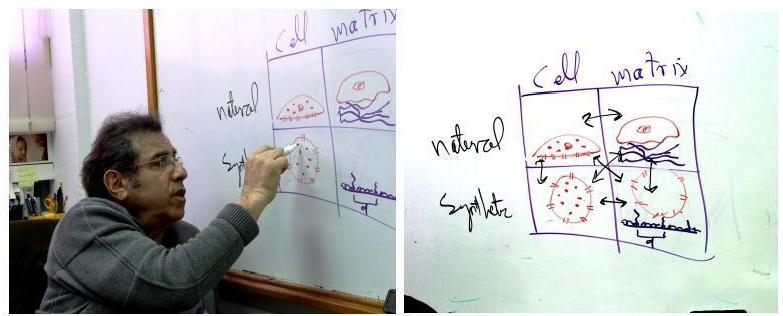What makes one cell stick to its home base and another cell detach and migrate? How do cells “sense” their physical environment and respond? These questions go to the core of what it means to be a living cell, but the answers are anything but simple. Indeed, some of the most complex cellular systems – from yeast to human cells – are those for adhesion and environmental sensing.
“Add to that the complexity of a dynamic environment,” says
Prof. Benjamin Geiger of the Weizmann Institute's Molecular Cell Biology Department, “and you have something that is very difficult to even define, much less describe in any useful way.”
That is why Geiger and Prof. Joachim Spatz of the Max Planck Institute for Intelligent Systems, Germany, have launched a project that presents a new approach to understanding the ways in which cells reach out to their surroundings. Simply put, they plan to conduct experiments with a man-made system in which synthetic cells – in the form of vesicles consisting of a simple lipid membrane and a handful of protein molecules – sit on synthetic substrates. Experimenting with these simplified models, in which the researchers can control every aspect of their design, will hopefully yield new insights into how living cells work. While the plan is admittedly ambitious, the payoff could be great: Adhesion and sensing are crucial to everything, from growth and development, to cell migration and tissue architecture, to – when the process goes awry – cancer metastasis.
The idea falls within the new field of synthetic biology, in which scientists take an engineering approach to the cell and its components. Spatz is a materials scientist and Geiger, a biologist. For the past several years, the two have worked closely together to create unique substrates, and used them to test living cells’ sensing abilities. Synthetic cells are the logical next step in the research process.
The scientists’ method for creating artificial cells begins with blood platelets – simple cells that have the ability to adhere to biological as well as artificial surfaces. The researchers remove everything but the cell’s outer “skin” and adhesion-mediating proteins, called integrins, which perform the actual sticking. Then, these proteins are extracted and inserted into synthetic vesicles, and additional components of the adhesion site are gradually added, a few at a time, so that the researchers can test as they go. In parallel, they will experiment with the substrate – controlling its properties down to the placement and spacing of individual molecules. As they analyze the results obtained from the synthetic system, Spatz and Geiger plan to recheck their findings in living cells, to see how well their progressing model reflects the considerably more complex reality.
Even such comparatively simple synthetic cell models are quite complicated. “If we manage to find the right combination to get these cells to respond to environmental cues,” says Spatz, “we will consider that a great success.” Eventually, the scientists intend to move past the present understanding – a “grocery list” of hundreds of individual molecules that participate in the molecular cross-talk underlying a cell’s adhesion and sensing mechanisms – toward understanding how those individual bits and pieces come together to make functional components.
This new undertaking has already demonstrated one considerable success: The European Research Council (ERC) recently awarded the project a grant of 3.5 million euros. Such ERC Advanced Grants are specifically “aimed to promote substantial advances at the frontiers of knowledge and to encourage new productive lines of enquiry, including unconventional approaches and investigations at the interface between established disciplines.”
In addition to advancing the understanding of how living cells sense and respond to their environment, the scientists think the project may yield some interesting insights into the origins of living cells. Even before cells started to stick together to form multicellular organisms, they probably had rudimentary adhesion mechanisms for sensing and grabbing onto food – the most basic need of all.
Prof. Benjamin Geiger’s research is supported by the Leona M. and Harry B. Helmsley Charitable Trust; the Adelis Foundation; the Mario Negri Institute for Pharmacological Research; the estate of Alice Schwarz-Gardos; IIMI, Inc.; and the European Research Council. Prof Geiger is the incumbent of the Professor Erwin Neter Professorial Chair of Cell and Tumor Biology.
